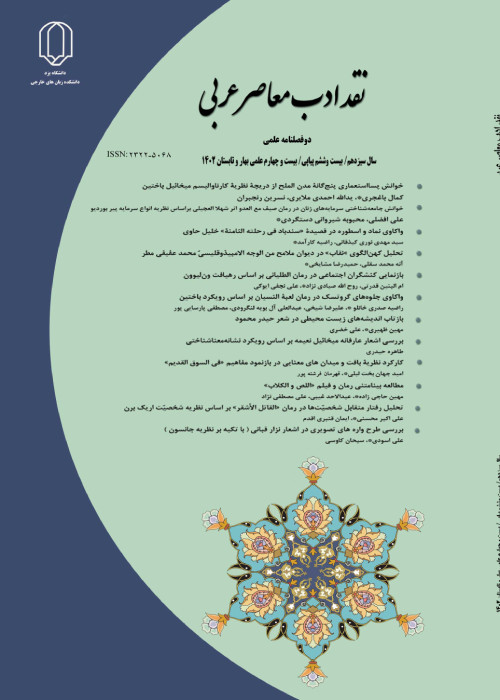Intertextual study of the novel and film "Al lis wa al kilab"
The relationship between fiction and cinema has occupied an important place in most books written about cinema. Theoretical ideas and practical perspectives and researches in the fields of convergence and divergence between these two categories have become the basis for many researches and studies around which different opinions and contradictory arguments have emerged.
In fact, today's literature, and especially novels and short stories, has unwittingly embarked on a path that shows a tremendous desire to become a filmmaker, and the works created in the field of fiction are similar to the works that are exemplary. We can clearly examine and determine the highlights in the field of cinema in some countries (Kheiri, 1989: 62). Watching any image or set of images (fixed or moving) makes us think. This thought does not necessarily mean the interpretation of the image or images, but since its source is the material existence of images, it is considered a moment from the horizon of its semantic implications (Ahmadi 1397: 24). It should be said that "thought is reconstructed visually" (Ibid: 25).
The interaction between the novel and the cinema is obvious and clear, and each of them needs the other, the cinema uses the previous narrative and opens new horizons. Cinema can provide important services for fiction that has been dusted off on library shelves and catered to a wide audience with diverse cultures. Matching a novel to a movie is more like renovating a house that we have to demolish from the inside before turning it into a beautiful house again.
In this article, the intertextual study and adaptation of the film "Al-Lis wa Al-Kilab" directed by "Kamal Al-Sheikh" from the novel of the same name by "Najib Mahfouz" has been done. The purpose of this article is to study the transition of "Al-Lass wa Al-Kalab" (1962) from one sign system to another sign system through intertextual study and by resorting to interdisciplinary translation. And study how it is represented in the multidisciplinary structure of cinema.
Because literature and cinema are two languages, which is characterized by "written" literature and cinema by "image", and because we live in an age where everyone wants to know a lot in the shortest possible time, and easily learn, In such circumstances, watching a film made from a literary work may be something of value by reading that work, but in a shorter time and more quickly (Kheiri, 1989: 37). On the other hand, the language of cinema is an all-encompassing language that has a universal aspect and provides the possibility of communication between human beings of any culture and race and in any temporal and spatial situation (Ibid: 37).
Even the simplest images are interpreted differently in different cultures. Reading a picture is a thought-provoking phenomenon. The eye chooses what it wants to see. An image is considered mental or imaginative before it is read physically. We also read the film in this sense. The purpose of visual semiotics is to discover the rules of this reading (Ahmadi 1397: 20).
The connection between semiotics and translation is strengthened by Jacobsen's semiotic approach to translation. In The Linguistic Aspects of Translation, Jacobsen introduces three types of translation: linguistic translation, interlinguistic translation, and inter-sign translation.
Given these views, it must be acknowledged that when we want to see a film adapted from a literary work, we should not consider that work as a model for judging the film; Rather, we must consider it an independent and pristine work composed of pictorial elements, not literary ones; And it was an impression that the filmmaker took from it.
These novels and films seem to be a collection of ideas and thoughts that the reader and the viewer cannot judge their content. Because Najib Mahfouz did not declare through the elements of the novel who is guilty and who is the victim. However, he has tried to suffice with the existence of a window through which decisions can be made about the character of Noor, who, in an attempt to justify his deviation, is claimed to have fallen victim to a society.
What was said was an intertextual study of the similarities and differences between the novel and the film Al-Lass wa Al-Kalab, relying on the inter-sign translation between the language system of the novel and cinema. Transferring the novel from its written text to the visual text, moving away from the rules and some of its characteristics, to pour into another artistic form. A close reading of Najib Mahfouz's novel, written after the 1952 Egyptian revolution, shows that Najib Mahfouz used this experience to critique the political and social situation of his time. Novel art techniques are very similar to cinematic technology and differ in the way they are presented; The novel is in the word, and the cinema is done with the camera. The novel Thieves and Dogs is a novel similar in its dramatic composition to movies; With a hero who tries to change his destiny in a tragic struggle. However, as observed in the present study, this film did not present the novel as it is and changed some of its layouts by using the flashback method, removing and repeating some of the characters. In these two visual and written works, an attempt was made to study the representation of the text of the novel in the sign system of cinema and to provide a reading of the content of the two works and the symbols of apple, music, tableau, Sheikh Junidi and woman as the most important conceptual signs of the two texts.
- حق عضویت دریافتی صرف حمایت از نشریات عضو و نگهداری، تکمیل و توسعه مگیران میشود.
- پرداخت حق اشتراک و دانلود مقالات اجازه بازنشر آن در سایر رسانههای چاپی و دیجیتال را به کاربر نمیدهد.




